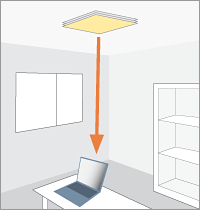Penn State is advancing Visible Light communication speeds and using non-visibile light to achieve 1 Gbps and higher speeds
In January 2010 a team of researchers from Siemens and Fraunhofer Institute for Telecommunications (Heinrich Hertz Institute in Berlin) demonstrated the transmission of 500 MBit/s with white LED over a distrance of 5 metres (16 ft) or 100Mbit/s over longer distance using 5 LEDs. Penn State has achieved over twice the speed.
There is a consortium of companies and research institutions that are working to advance this technological approach
Optical communications systems could provide faster, more secure communications with wider bandwidth and would be suitable for restricted areas like hospitals, aircraft and factories.
The system uses a high-powered laser diode -- a device that converts electricity into light -- as the optical transmitter and an avalanche photo diode -- a device that converts light to electricity -- as the receiver. The light bounces off the walls and is picked up by the receiver.
"Unless the walls are painted solid black, there is no need to worry about transmission within a room," said Jarir Fadlullah, graduate student in electrical engineering who presented the paper Tuesday (Jan. 27) at SPIE Phonotics West Conference in San Francisco, the paper will be published in the conference proceedings.
The researchers tested infrared light, but the system also will work with visible light and ultraviolet light.
"The optical system we have offers a very large bandwidth thus a very high speed," said Fadlullah. "We can send one gigabit per second or more over a gigahertz band."

Radio frequency systems do not require line of sight transmission, but can pass through some substances and so present a security problem. Light, in a room without windows, will not escape the room, improving security, but also allowing the same frequencies to be used in adjacent rooms without interference. Multiple sensors could allow the light signal to pass from room to room or even from floor to floor. The system could also be set up to convert the signal to electricity, transfer it to another location and change it back to light.
"The safest security is physical layer security," said Mohshen Kavehrad. "If you first have to break into the building before you can attack the network it makes it very difficult."
He also said an optical system can operate in locations where radio frequency transmission would interfere with other equipment, especially in hospitals, aircraft and even some factories. Because this system is optical, it will not interfere with the radio frequency emissions of navigation equipment, medical devices or factory control systems.
Optical transmissions can transfer sensor data and unlike radio frequency communications, also can distribute high-resolution images.
"One application for this system would be wireless projection of high definition television," said Kavehrad. "Currently, two high definition broadcasts exceed the bandwidth of any radio system, but with a 1.6 gigabit per second gigabit system, two HD channels could be broadcast."
While this application in conference rooms could provide mobility for presentations, applications in aircraft and medical facilities are probably more important. Currently, wireless communications are difficult in these situations because radio frequency systems can interfere with equipment using radio frequency control or communications. An optical system can operate in the same space as a radio system without interference.
"As far as I know, these are the first set of measurements for indoor optical wireless links that show the feasibility of the highest bit rates with no line-of-sight," said Kavehrad. "No radio system had comparable ability."
The researchers will continue to test optical systems, looking at visible and ultra violet light. They also believe that light emitting diode room lighting could be incorporated into the systems to provide a blanket communications network. The researchers note that this is a very green technology.


In January 2010 a team of researchers from Siemens and Fraunhofer Institute for Telecommunications (Heinrich Hertz Institute in Berlin) demonstrated the transmission of 500 MBit/s with white LED over a distrance of 5 metres (16 ft) or 100Mbit/s over longer distance using 5 LEDs. Penn State has achieved over twice the speed.
There is a consortium of companies and research institutions that are working to advance this technological approach
Optical communications systems could provide faster, more secure communications with wider bandwidth and would be suitable for restricted areas like hospitals, aircraft and factories.